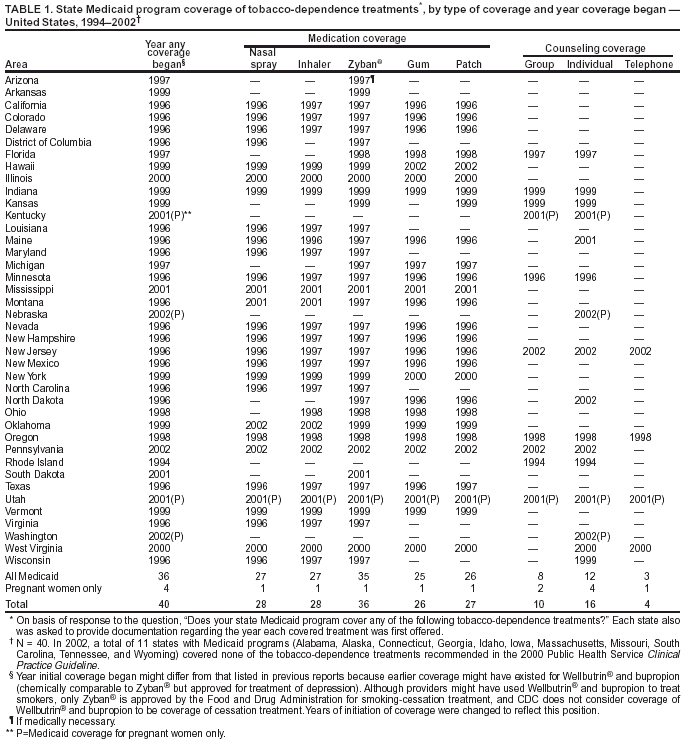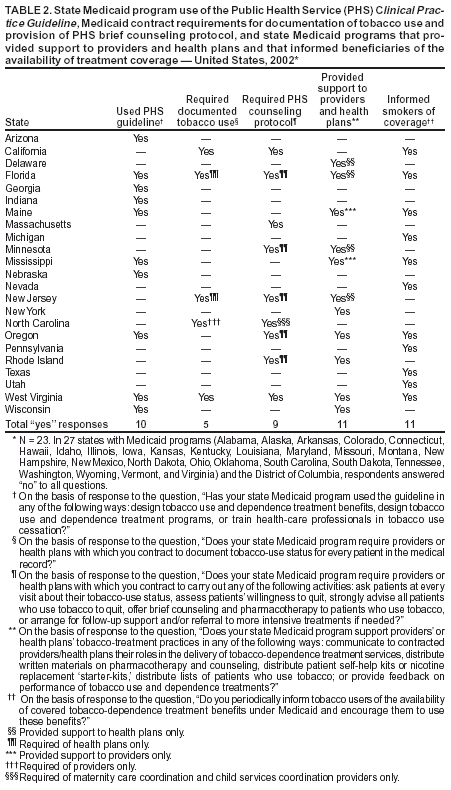State Medicaid Coverage for Tobacco-Dependence Treatments --- United States, 1994--2002
Download PDF Version What is PDF?
Reported by: HA Halpin, PhD, SB McMenamin, PhD, CL Keeler, Center for Health and Public Policy Studies, School of Public Health, Univ of California, Berkeley. CT Orleans, PhD, Robert Wood Johnson Foundation, Princeton, New Jersey. CG Husten, MD, Office on Smoking and Health, National Center for Chronic Disease Prevention and Health Promotion, CDC.
Source:
Centers for Disease Control and Prevention, State
Medicaid Coverage for Tobacco-Dependence Treatments
--- United States, 1994--2002, MMWR, 53(03);54-57, January 30, 2004
Public Domain
Table of Contents (TOC)
Article: State Medicaid Coverage for Tobacco-Dependence Treatments --- United States, 1994--2002Editorial Note
Tables
References
In 2000, of approximately 32 million persons who received health insurance coverage through Medicaid programs,1 an estimated 11.5 million (36%) smoked (CDC, unpublished data, 2000). One of the national health objectives for 2010 is to provide coverage by Medicaid in the 50 states and the District of Columbia (DC) for nicotine-dependence treatment (objective 27.8b).2 The Guide to Community Preventive Services recommends reducing the cost of tobacco-dependence treatments to increase the number of smokers who successfully quit smoking.3 The 2000 Public Health Service (PHS) Clinical Practice Guideline also supports expanded insurance coverage for tobacco-dependence treatments.4 The amount and type of coverage for tobacco-dependence treatment offered by Medicaid has been reported previously for 1998, 2000, and 2001.5, 6, 7 In 2002, all states and DC were surveyed again about the amount and type of coverage they provided. This report summarizes the results of the survey, which indicate that as of December 31, 2002, 1) 36 Medicaid programs covered some tobacco-dependence counseling or medication for all Medicaid recipients, 2) four states offered coverage only for pregnant women, 3) two states offered coverage for all pharmacotherapy and counseling treatments recommended by the 2000 PHS guideline, and 4) seven states covered all recommended medications and at least one form of counseling. To improve the health of populations with disproportionately high rates of smoking, the 50 states and DC should provide coverage under Medicaid for all recommended tobacco-dependence treatments.
In 2002, state Medicaid program directors were asked to identify staff members who were most knowledgeable about tobacco-dependence treatment coverage and programs; a survey was faxed to the identified staff member in each state and DC. After additional follow-up was conducted through telephone, e-mail, and fax, the response rate was 100%. The survey included 25 questions about coverage of tobacco-dependence treatments, the year coverage was first offered, treatments offered specifically to pregnant women, awareness and use of the 2000 PHS guideline,4 any program requirements related to patient copayments for or provider coverage of tobacco-dependence treatments, and whether Medicaid recipients were notified of the availability of covered tobacco-dependence treatments. So that survey responses could be validated, all Medicaid program respondents were asked to submit a written copy of their coverage policies for tobacco-dependence treatments or other related documentation. Of 40 Medicaid programs that reported offering coverage, 30 (75%) provided supporting documentation (i.e., detailed benefit documentation [23], drug benefit documentation [four], and substance abuse benefit documentation [three]). Ten (25%) programs did not submit any documentation.
 In 2002, a total of 36 (71%) Medicaid programs reported
offering coverage for at least one form of tobacco-dependence
treatment for all Medicaid recipients (Table
1); in 2001, a total of 35 programs offered coverage.7 In 2002, four other
states reported covering tobacco-dependence treatments only
for pregnant women; in 2001, two programs covered these
services for pregnant women. Of the 36
programs that offered some coverage to all Medicaid recipients
in 2002, all but one covered pharmacotherapy treatments,
including Zyban® (GlaxoSmithKline, Research
Triangle Park, North Carolina) (35 programs), nicotine nasal
spray (27), nicotine inhaler (27), nicotine patch (26),
and nicotine gum (25). In 2002, among the 35 Medicaid programs
covering any pharmacotherapy treatments for all Medicaid
recipients, 20 (57%) required some form of patient cost
sharing (range: $1--$3 per prescription); in 2001, a total
of 16 states required cost sharing (range: $0.50--$3 per
prescription).
In 2002, a total of 36 (71%) Medicaid programs reported
offering coverage for at least one form of tobacco-dependence
treatment for all Medicaid recipients (Table
1); in 2001, a total of 35 programs offered coverage.7 In 2002, four other
states reported covering tobacco-dependence treatments only
for pregnant women; in 2001, two programs covered these
services for pregnant women. Of the 36
programs that offered some coverage to all Medicaid recipients
in 2002, all but one covered pharmacotherapy treatments,
including Zyban® (GlaxoSmithKline, Research
Triangle Park, North Carolina) (35 programs), nicotine nasal
spray (27), nicotine inhaler (27), nicotine patch (26),
and nicotine gum (25). In 2002, among the 35 Medicaid programs
covering any pharmacotherapy treatments for all Medicaid
recipients, 20 (57%) required some form of patient cost
sharing (range: $1--$3 per prescription); in 2001, a total
of 16 states required cost sharing (range: $0.50--$3 per
prescription).
In 2002, a total of 12 states offered some form of tobacco-cessation counseling services to all Medicaid recipients (Table 1), compared with nine in 2001, and Nebraska and Washington added counseling coverage for pregnant women only. Rhode Island offered counseling services for all Medicaid recipients but did not provide coverage for any drug treatments.
In 2002, Medicaid program staff in 10 (20%) states reported using the PHS guideline to design treatment benefits, design treatment programs, or train health-care providers (Table 2). Five (10%) states required providers or health plans to document tobacco-use status in patients’ medical charts, nine (18%) states required contracted providers or health plans to implement the brief counseling protocol recommended by the 2000 PHS guideline, and 11 (22%) states supported tobacco-dependence treatment practices§. Of 40 Medicaid programs that provided coverage for tobacco-dependence treatment, 11 (28%) informed recipients that tobacco-dependence treatment benefits were available.
During 2001--2002, the number of Medicaid programs offering coverage for any form of tobacco-dependence treatments increased slightly. However, comprehensive coverage for treatments recommended by the 2000 PHS guideline remained low. In 2002, only New Jersey and Oregon offered coverage for all recommended treatment options; 11 states offered no coverage for tobacco-dependence treatments. In addition, four states restricted coverage to pregnant women, and the number of states requiring copayments for treatment increased. Such cost sharing decreases use of treatment,8 particularly for low-income populations. Because decreasing the cost of effective treatments increases successful smoking cessation,3 cost barriers for low-income smokers should be reduced. In addition, because only 28% of states that offer coverage inform their beneficiaries of these benefits, Medicaid recipients interested in quitting might not realize they can obtain financial assistance for tobacco-dependence treatments.
 The findings in this report are subject to at least two limitations.
First, 10 (25%) of the 40 states with Medicaid programs that reported
offering coverage did not provide documentation of their policies. The
absence of a written policy increases the likelihood of reporting errors.
Second, these results might differ from other ratings of coverage because
of interpretation of unwritten policies.
The findings in this report are subject to at least two limitations.
First, 10 (25%) of the 40 states with Medicaid programs that reported
offering coverage did not provide documentation of their policies. The
absence of a written policy increases the likelihood of reporting errors.
Second, these results might differ from other ratings of coverage because
of interpretation of unwritten policies.
Because smoking prevalence among Medicaid recipients is approximately 50% greater than that of the overall U.S. adult population,6 persons receiving Medicaid are affected disproportionately by tobacco-related disease and disability. To help states implement evidence-based tobacco-dependence treatment and improve Medicaid service contracts, CDC collaborated with George Washington University to develop model purchasing specifications.9 These specifications encourage state Medicaid contracts to require health-care providers and health plans to adopt the brief counseling protocol and systems components outlined in the 2000 PHS guideline. States also are encouraged to use their contracts to track the number of Medicaid smokers and the number who receive advice to quit, brief cessation counseling, and medication. Finally, states are encouraged to cover all recommended pharmacotherapies and counseling under Medicaid and to promote their use actively. Information that states can use to support the need for Medicaid programs to cover tobacco-dependence treatments is available from the Center for Tobacco Cessation at http://www.ctcinfo.org. Providing comprehensive coverage of tobacco-dependence treatments is essential to reduce both tobacco-related disease and premature death for Medicaid recipients and health-care costs for state Medicaid programs.


1. Kaiser Family Foundation. Medicaid enrollment: Kaiser Commission on Medicaid and the Uninsured. Washington, DC: Kaiser Family Foundation, 2000.
2. U.S. Department of Health and Human Services. Healthy People 2010, 2nd ed. With Understanding and Improving Health and Objectives for Improving Health (2 vols). Washington, DC: U.S. Department of Health and Human Services, 2000.
3. Hopkins DP, Briss PA, Ricard CJ, et al. Reviews of evidence regarding interventions to reduce tobacco use and exposure to environmental tobacco smoke. Am J Prev Med 2001;20(suppl 2):16--66.
4. Fiore MC, Bailey WC, Cohen SJ, et al. Treating tobacco use and dependence: clinical practice guideline. Rockville, Maryland: U.S. Department of Health and Human Services, Public Health Service, 2000.
5. Halpin Schauffler H, Barker DC, Orleans CT. Medicaid coverage for tobacco dependence treatments. Health Aff 2001;20:298--303.
6. CDC. State Medicaid coverage for tobacco-dependence treatments---United States, 1998 and 2000. MMWR 2001;50:979--82.
7. CDC. State Medicaid coverage for tobacco-dependence treatments---United States, 1994--2001. MMWR 2003;52:496--500.
8. Solanki G, Halpin Schauffler H. Cost-sharing and the utilization of clinical preventive services. Am J Prev Med 1999;17:127--33.
9. George Washington University Medical Center School of Public Health and Health Services. Purchasing Specifications: Tobacco-use Prevention and Cessation. Available at http://www.gwhealthpolicy.org/newsps/tobacco.


